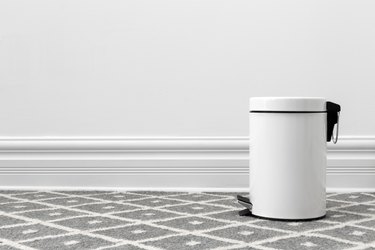
Warm air rises, and if your house isn't properly sealed, this air escapes through the ceiling and walls, drawing cooler air from below to replace it. The gaps between the baseboards and the walls are a likely place for this cool air to enter. You can prevent baseboard drafts by sealing these gaps, but to solve the problem comprehensively, and keep your energy bills down, you need to also seal the walls and ceiling.
The Chimney Effect
Video of the Day
The upward movement of air through your house resembles the flow of hot air up a chimney. Warm air tends to collect around the ceilings, creating a semi-vacuum near the floor. If the house is perfectly sealed, the air will recirculate downward to fill this vacuum, but even a small gap that allows air to escape will prevent this recirculation. Instead, the vacuum will eventually become strong enough to draw air from outside through any available gap -- usually in a poorly sealed door or window or through the gap between a wall and the floor.
Video of the Day
Preventing Heat Loss
Even though your ceiling looks properly sealed, numerous small gaps probably exist. The most common are between ceiling light fixtures and the ceiling, and this is especially true if you have recessed lighting. Sealing your dome lights, pendant light bonnets and recessed lighting canisters with caulk goes a long way toward preventing heat loss to upper floors in your house. There isn't much you can do to completely eliminate upward drafts on a stairway, but sealing upstairs windows with caulk and keeping them closed in cold weather reduces them. Keeping bedroom doors closed also helps.
The Importance of Sealing Baseboards
Sealing the upper portion of your house probably won't eliminate drafts through the baseboards altogether. The gap between the wall and the floor that a baseboard typically covers can be as wide as an inch, and there is often a direct path between the bottom of the wall plate and the crawl space. Moreover, walls often curve inward in places, creating large spaces for air to enter. Even in the absence of a significant updraft, cold air is bound to enter unless you seal the gap between the baseboard and the wall.
Procedure for Sealing Baseboards
Painters usually seal baseboards with acrylic latex caulk before painting them. If the caulk on your baseboards is missing or has peeled off, it isn't difficult to apply more. Remove any old caulk and run two beads of paintable or clear caulk -- one along the top of the baseboard and one along the bottom. If the floor is carpeted, pull the carpet off the tack strip and away from the wall and caulk between the baseboard and subfloor. Wait for the caulk to set before replacing the carpet. If the gap between the wall and floor is wide, and the draft particularly strong, remove the baseboard and spray foam insulation into the gap.